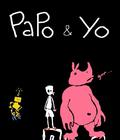Sony's Pub Fund initiative has funded an array of unusual concepts in recent years, providing some independent studios a chance to explore new ideas. With Papo & Yo, Vander Caballero and the Montreal-based studio, Minority, take their swing at a game that carries meaning, if in strange ways. At E3, I sat down with Caballero, chatted about the game, and then played it. There are some very interesting concepts here from a man who had previously led games like Boogie and Army of Two.
The biggest idea of the game was to be loosely autobiographical, "inspired by" bits of the true story of his life, but told in a uniquely fantastic fashion, full of metaphor and inspiration. Sadly, his story's centerpiece is of the classic "Father is a drug addict" variety, but he's harnessed this into an intense concept and amount of inspiration by using clever symbolism to draw a meaning greater than the sum of its parts.
The game's main character is a young boy named Quico, whose closest friends are a jetpack-toting robot named Lula and a monster named Monster. Lula doesn't like Monster so much because he's addicted to frogs, and when he eats frogs, he becomes extremely angry and dangerous to Quico. In the name of saving her friendship, Quico must find a way to cure Monster of his addiction. In his discussion with me, Caballero directly likened the frog addiction to alcoholism, though in past interviews, he's referred to drugs in general. For him, early video games were an escape in bad times, and now, he wants to create games that will bring joy to others in bad times.
Certainly, he could do a lot worse than the creative platforming adventure he's designed. The urban environments — as bright and colorful as they are gritty and dirty — provide a backdrop where magic can actively influence the environment. A strange child, Alejandro, provides magic by drawing things on surfaces with magic chalk, and Quico can interact with the sketches, which in turn shift the environment. In the demo, the most basic example of this was that if you saw incomplete gears in a wall, you might push one into place, causing the entire wall to shift. More elaborate examples sent houses flying to form a tower, which Quico could shift with a switch. Then the entire row of houses bent into a ramp that led to her next destination.
Monster and Lula also provide help. When Monster is asleep, Quico can climb on his belly and use it as a springboard to leap to decent heights. He can also be guided with fruit to provide Quico a lift. Lula provides Quico with a short boost when jumping; though it's not enough to constitute a double-jump, it carries Quico just a bit farther each time — enough, perhaps, to make that next jump.
Similarly, the other elements are either creative twists or involved in the game's increasingly complex symbolism. Hints are drawn on the insides of boxes, and Quico reads them by putting on the box. Her outfit changes from a prim and proper school uniform to a native appearance as the game goes on. Environments slowly grow more fantastic over time, and the chalk's motions, smooth as silk while still looking like individual sketch frames, are a particular standout.
Papo & Yo is a very complex metaphor for an all too common phenomenon. If Caballero's goal is to provide people a creative escape for the agonies of life, he is certainly on the right track. When the title comes out on PlayStation Network later this year, those who want to explore the nature of games as art should give this a glance.
More articles about Papo & Yo











 Papo & Yo introduces players to a boy named Quico and his new best friend, Monster, a cuddly creature with an unfortunate addiction to poisonous frogs. Players will lead Quico though a vibrant, 3D adventure, solving puzzles with Monster’s help… but they’ll have to avoid being torn limb from limb by his amphibian-fueled rage in the process.
Papo & Yo introduces players to a boy named Quico and his new best friend, Monster, a cuddly creature with an unfortunate addiction to poisonous frogs. Players will lead Quico though a vibrant, 3D adventure, solving puzzles with Monster’s help… but they’ll have to avoid being torn limb from limb by his amphibian-fueled rage in the process. 


